| |

Karen and I had another busy day today. I'm going to tell you about our morning dives on the Heian Maru and then our dive on the Yamagiri Maru. Then, I'll tell you a little about the scuba equipment we use on all of our dives, and how this gear helps us explore underwater.
The Heian Maru
(Click on any photo to enlarge it.)
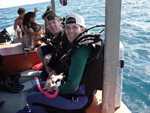 Today Karen and I dove on the Heian Maru. Heian means "swallow bird" in Japanese. This was the largest ship sunk during the 1944 invasion of Chuuk (Truk) Lagoon. During the war, the Japanese used this great ship as a submarine tender. As the name implies, the Heian Maru carried supplies such as torpedoes for the Japanese fleet of submarines.
Today Karen and I dove on the Heian Maru. Heian means "swallow bird" in Japanese. This was the largest ship sunk during the 1944 invasion of Chuuk (Truk) Lagoon. During the war, the Japanese used this great ship as a submarine tender. As the name implies, the Heian Maru carried supplies such as torpedoes for the Japanese fleet of submarines.
As soon as I dropped off the dive boat into the water, I could make out the shape of this hefty ship. Unlike the Fujikawa Maru that lies perfectly upright, the Heian turned on its port (left) side as it sank to the bottom. As I reached the top edge of the starboard (right) side of the ship, I flicked on my light and entered into a walkway. Almost immediately my light beam reflected off of a long tube-shaped object. At first I could not figure out what it was. Following the object further and remembering what this ship was used for, I realized that this was a periscope, which was being transported by the ship for delivery to a submarine.
I swam out of the walkway and quickly dropped down into cargo hold #2. My dive light immediately illuminated a row of long cylindrical objects, each at least 14 feet in length. As I swam closer I noticed that each one of these long cylinders had a small propeller at the end. Torpedoes! I had found the torpedo storage area. I never realized just how large a torpedo actually was. Alongside them was a collection of very large artillery shells. After getting a closer look at the artillery shells, a quick glance at my watch told me it was time to head back to the surface.
Time is the battle when you dive this deep. The amount of time spent on a dive affects both the amount of air you have in your scuba tank as well as the amount of nitrogen your body is absorbing. The longer I stay on the Heian Maru, the longer it will take me to get to the surface. If I stay down too long and then come up too quick, I could get decompression sickness, also known as the "bends." Divers get decompression sickness when they don't eliminate the nitrogen from their bodies. The nitrogen forms tiny bubbles in the diver's body that can cause severe pain and even death if the symptoms are not treated by recompression.
Yamagiri Maru
After a quick lunch and a short rest, our boat anchored above the wreck of the Yamagiri Maru. Yamagiri means "mountain fog" in Japanese. This was the first ship found in the lagoon in the late 1960s. Just like the Heian, the Yamagiri rests on the bottom at 110 feet tipped on its port side. This 439-foot vessel was struck several times by bombs during the attack but what sank the ship was a direct hit by a torpedo dropped from a U.S. plane.
As I floated down onto the starboard side of the ship, I could make out the enormous hole blown through the bottom of the vessel by the fatal torpedo. Three of us were able to easily enter side by side through this large opening in the ship's hull (bottom) and swam through the ship, coming out on its deck. As I headed down the deck back toward the stern, several large barracuda decided to tag along, just like a couple of puppies might follow their master. Both hard and soft corals covered the wheelhouse and as I illuminated them with my dive light, their true reddish colors were revealed.
Reaching hold #5, my main destination, I gave a quick look around to see if my two pet barracudas were still following (they weren't), then swam in. This hold contained a large number of 18-inch bombshells. These large shells were destined for use by two Japanese battleships, the Yamato and the Musashi.
Once again my time was up way too soon, and so I reluctantly headed back up to the dive boat. My slow ascent to the surface gave me time to reflect on what I had seen over the past few hours. During these last two dives I saw more bombs, torpedoes, large shells and other large weapons of war than I have seen in my lifetime. I feel lucky that I've lived in the United States and am at an age that I have not had to be involved in a war. I've also gained an even greater respect for all individuals that have served in the armed forces for their country and face the odds presented to them by such large implements of destruction.
Scuba Equipment
Already on this adventure, Karen and I have scuba dived in some of the world's most famous shipwrecks. Do you know what scuba means? Scuba is an acronym that stands for Self-Contained Underwater Breathing Apparatus. Let's take a look at scuba gear, and how it helps to keep you safe underwater.
Mask
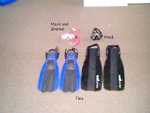 We need to wear a scuba mask to see underwater. Underwater, light behaves differently than it does above water, in air. Since our eyes are used to focusing according to how light acts in air, when we go underwater, our eyes can't focus as well and everything looks blurry. The mask, made out of silicone rubber with a tempered-glass lens, creates an air space between our eyes and the water so our eyes can focus.
We need to wear a scuba mask to see underwater. Underwater, light behaves differently than it does above water, in air. Since our eyes are used to focusing according to how light acts in air, when we go underwater, our eyes can't focus as well and everything looks blurry. The mask, made out of silicone rubber with a tempered-glass lens, creates an air space between our eyes and the water so our eyes can focus.
Snorkel
Divers sometimes use snorkels so they can rest or swim with their faces in the water. Snorkels also help divers to breathe if there is a surface chop (splashing waves) that would otherwise get in their mouths. Since Karen and I will be wreck diving and penetrating (swimming into the wrecks), we will not be using snorkels on our dives. Snorkels are made out of silicone and plastic.
Fins
Fins provide a large surface area so our powerful leg muscles can move us through the water. Our fins are made out of several materials. The foot pockets and heel straps are made from neoprene rubber and the blades are made from a type of plastic.
BCDs
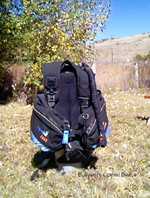 A Buoyancy Control Device (BCD) is an expandable bladder (pouch) that allows us to control how high or low we float. We will inflate the BCD if we want to float higher or deflate it if we want to sink lower. We can inflate the BCD by blowing it up (like you would a balloon), or by using an inflator hose, which fills the BCD with air from our tank. BCDs are made from a coated fabric that serves to hold air and resists cuts, punctures, and abrasions.
A Buoyancy Control Device (BCD) is an expandable bladder (pouch) that allows us to control how high or low we float. We will inflate the BCD if we want to float higher or deflate it if we want to sink lower. We can inflate the BCD by blowing it up (like you would a balloon), or by using an inflator hose, which fills the BCD with air from our tank. BCDs are made from a coated fabric that serves to hold air and resists cuts, punctures, and abrasions.
Scuba Tank
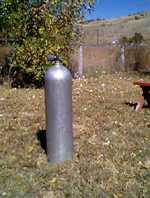 The scuba tank is a cylindrical metal container that safely stores high-pressure air so we can breathe underwater. The tanks that Karen and I use are made out of aluminum and hold 80 cubic feet or 3,000 psi (pound per square inch) of air. It is important to remember that when we breathe air from a scuba tank, it is not pure oxygen. Pure oxygen becomes deadly due to its partial pressure if we breathe it at depths more than 20 feet. Therefore, the air in scuba tanks is a combination made of 79% nitrogen and 21% oxygen.
The scuba tank is a cylindrical metal container that safely stores high-pressure air so we can breathe underwater. The tanks that Karen and I use are made out of aluminum and hold 80 cubic feet or 3,000 psi (pound per square inch) of air. It is important to remember that when we breathe air from a scuba tank, it is not pure oxygen. Pure oxygen becomes deadly due to its partial pressure if we breathe it at depths more than 20 feet. Therefore, the air in scuba tanks is a combination made of 79% nitrogen and 21% oxygen.
Regulator
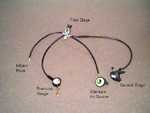 We need a regulator to be able to use the air from our tanks. The air in our scuba tanks is stored at a very high pressure that we cannot inhale. A regulator reduces the pressure of the air in the tank to match the surrounding water pressure so that it is safe to inhale. Attached to the regulator is a low-pressure inflator hose. This hose connects to the BCD and a submersible pressure gauge that tells us how much air we have left in our tanks. Regulators also have an alternate air source that allows us to share air with another diver if the need arises. The regulator is made out of chrome-plated brass and high impact plastic.
We need a regulator to be able to use the air from our tanks. The air in our scuba tanks is stored at a very high pressure that we cannot inhale. A regulator reduces the pressure of the air in the tank to match the surrounding water pressure so that it is safe to inhale. Attached to the regulator is a low-pressure inflator hose. This hose connects to the BCD and a submersible pressure gauge that tells us how much air we have left in our tanks. Regulators also have an alternate air source that allows us to share air with another diver if the need arises. The regulator is made out of chrome-plated brass and high impact plastic.
Wetsuits
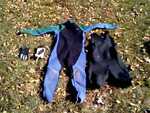 The wet suits that Karen and I will be wearing will help reduce heat loss by putting a layer of insulation over our skin. These suits are made out of a material called neoprene. Water will enter our suits at the wrists, ankles, and neck and get trapped between our skin and the suit. Our body temperature will warm this trapped water and keep us comfortable during our dives.
The wet suits that Karen and I will be wearing will help reduce heat loss by putting a layer of insulation over our skin. These suits are made out of a material called neoprene. Water will enter our suits at the wrists, ankles, and neck and get trapped between our skin and the suit. Our body temperature will warm this trapped water and keep us comfortable during our dives.
Accessories
| Watch: |
Our watch will help us keep track of how long we have been on our dive. |
| Computer: |
This will keep track of time, depth, and other important information to help us keep safe while diving. |
| Reel: |
When we go inside a wreck, we need to have a continuous line that will lead us back outside of the wreck. Our dive reel is approximately 130 feet long. |
| Lights: |
Inside a wreck, it is very dark because no sunlight can reach there. So, we'll need dive lights to see. Both Karen and I will carry 1 large primary light and 2 back-up lights. |
| Slate: |
Underwater slates are used to write messages and record important information. |
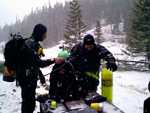 Finally we need to go and make a quick dive to make sure all of our equipment is in good working order. This can often be difficult when you live in the mountains of Colorado, especially when it's snowing!
Finally we need to go and make a quick dive to make sure all of our equipment is in good working order. This can often be difficult when you live in the mountains of Colorado, especially when it's snowing!
Now that you know all about scuba gear, are you ready to strap some on and get diving? I sure am! I'll do some more diving tomorrow and tell you all about it.
Talk to you soon,
Tom
|


